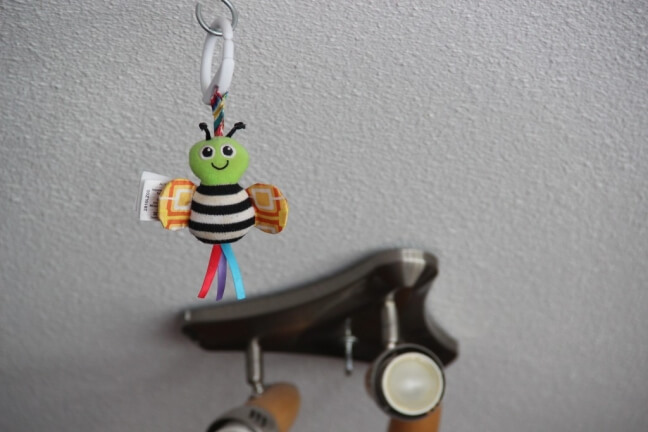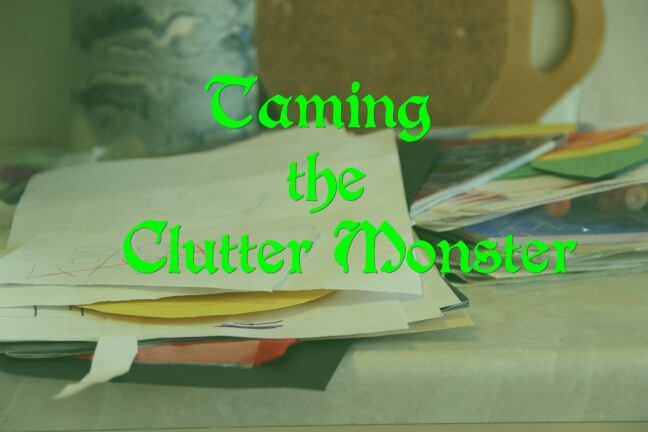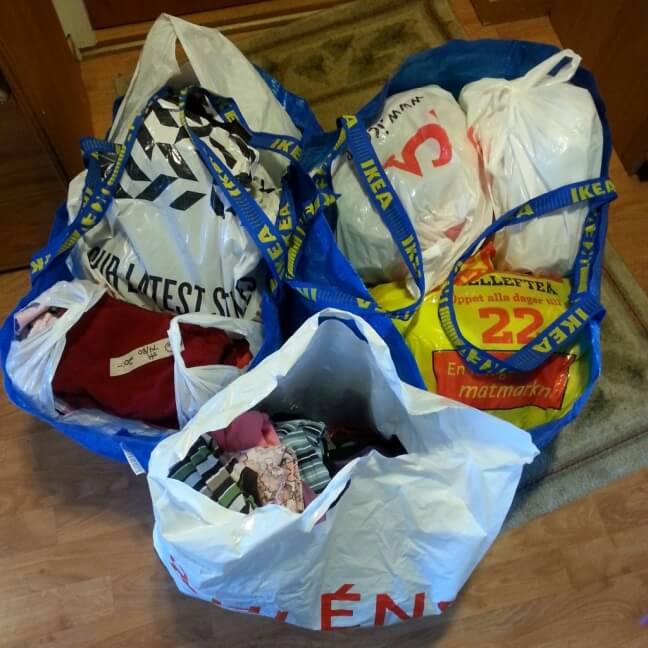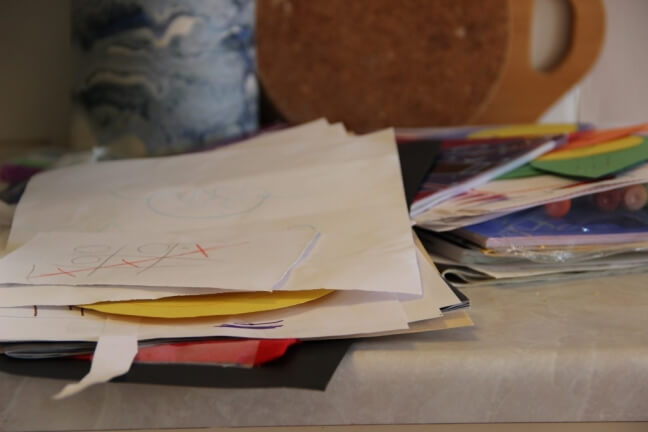“A place for everything, and everything in its place” has always been a bit out of reach for me. While I like it in theory, it always evokes an image of a woman wearing those stereotypical librarian glasses on a chain with her hair pulled tightly back into a bun, as though nothing out of place refers just as much to hair as to things. In other words, the expression always seemed rigid, boring and stuffy to me (no offense intended if your personal style involves tight buns and glasses on a chain). I’m a creative type, so I’m supposed to be messy, right? And yet, when the clutter starts to feel overwhelming, these words seem among the wisest ever spoken.
I recognize it even more easily in my kids. They have a much easier time cleaning up toys when they know where to put them. Legos go in the Lego bin and books on the bookshelf – that’s easy. But the things that don’t have a specific home are much more confusing. When left to themselves, they stack all of these things on their beds, and thus defer the problem until bedtime, when there’s no place to sleep. If we point out this problem, the response is a whiny, “But I don’t know where else to put it!” Having specific places to put our things is helpful at any age.
While this remains a struggle for us, I have to say that we’ve improved a lot in the last few years. Naturally, this has a lot to do with our decision to own less stuff. But the shift in my mindset started about the time that Emelie was starting to be more mobile and we started thinking about how to keep both her and our stuff safe from each other. I just kept moving things higher and higher up a she grew, but knew all along that this was not a long-term solution, just deferring the problem until later. I was reluctant to put away things that were “in use” in some way… the things I wasn’t finished with. I realized that my attitude toward storage – closets, drawers, cabinets, etc. – was that it was for the things we rarely or never use. This meant that the things we used regularly were never really put away. The bureau was full of clothes I never wore, so the things I wore more often were on top of it, or thrown over a chair. Paperwork and mail that I needed to keep track of had to stay on the table, because otherwise “out of sight out of mind.” I was a master with piles and I could usually find what I needed, unless what I needed was a flat surface to start a new pile. When people came over, the piles got moved and hidden away in the bedroom, only to be put back when everyone was gone. It worked, in a sense, but it always looked and felt very cluttered. And it was impossible to childproof. The monster needed to be tamed.
Here are some of the things we’ve done in the last 5 years to help us tame the clutter monster, as well as some of what we didn’t choose to do and some potential next steps for us.
What we did:
We decided. Motivation is so important. I had made attempts before that never effected any real change because my motivation was wrong, usually concerned with what other people thought. The instinct to keep my child safe was a powerful motivator. So was finally realizing how the clutter was effecting my well-being. I didn’t even realize how much my cluttered living space made my mind feel cluttered until we started cleaning it up. As it turns out, being messy wasn’t so positive for creativity after all. It’s great having space to think and space to create.
We Purged. In some cases, ruthlessly. I’ve read a lot of advice and how-to’s about deciding what to keep and what to get rid of, and we’ve employed parts and pieces of everybody’s systems and made it our own. I think that’s the only way to do it. It’s been so helpful reading about how others have simplified their belongings, but it doesn’t work to simply reproduce what others have done. We are still learning and we are still purging. But one of the things that has been the most surprising is how addictive it is. It was so hard to get started, and I couldn’t imagine it would ever get easier. Little did we know how intoxicating it would be, this feeling of freedom that comes with reducing our possessions. It’s hard to explain. You have to experience it for yourself.
Twice a year we’ve taken bags of kids clothes and accessories to a “clothing exchange” day. We mark everything for sale and the stuff that isn’t purchased is donated. We clean out what we’re done with and find new homes for it, while getting “new” things in their current sizes. In the end we have what we need, more space, and usually a little extra money leftover. Win!
We Filter. As we got rid of things that had claimed too much space for too long, we regretted the money, time and energy we’d spent on buying them, moving them, cleaning and maintaining them. We made a conscious decision to save our future selves from too many similar experiences by trying to prevent many of these kinds of things from coming into our home in the first place. Sometimes it was simple, like switching bank statements, credit card statements, and other regular mail to electronic paperless options wherever possible. Less mail to sort, less paper to file and store, and better for the environment. Other times it was more sensitive and emotional, like talking to friends and family about gifts that help us live the life we want and those that don’t. What makes the most difference, though, is our shopping habits. It’s not that we’re cheap, although the benefit to our budget is a wonderful side effect, but that we are simply selective about what we allow into our home. We need so much less than we think we do.
What we did NOT do:
Get more space. We did not move into a larger apartment, or buy a house with a garage. We did not rent a storage unit. Doing so is equivalent to moving piles of clutter to a higher shelf or our kids stacking toys on their beds. It’s deferring the problem. Without changing our habits, we would soon have filled up however much space we had. “Enough” square footage to solve this problem is an endless pursuit. We have made some adjustments to use the space we have in smarter, more efficient ways. We are a family of four living in a two-bedroom apartment with 76 square meters (about 800 square feet) and what we’d really like is to move into something smaller.
Invest in “organizing systems”. It’s a truly first-world problem we’re discussing here, isn’t it? We have so much stuff we can’t figure out what to do with it all. And we have enough money left over after buying all the stuff to invest in ways to organize it all. It’s big business these days, though one that I know very little about. It’s amazing how simple it is to organize your stuff when you have less of it. I am a big fan of smart, space-saving solutions (hello, we live in the land of IKEA!) but the idea of walking into The Container Store makes me feel itchy all over.
List or count our possessions. Apparently this is a thing. I guess there’s some kind of club for people who have less than 100 possessions, and they discuss things like whether shoes should be counted as 1 pair or 2 distinct items. I have been very inspired by the idea of Project 333 and I may one day try it, but as yet I have not counted my articles of clothing. Right now it’s enough for me to be working on reducing my wardrobe by giving away the things I don’t like, don’t wear, or that don’t fit. I’m sure it’s helpful for some people, but right now itemizing our possessions feels like misdirected energy.
Next steps:
Paper. Oh the paper. Can’t somebody save us from the paper?! Okay, junk mail goes straight into the recycling and bills and other important documents go on the desk for payment, filing, etc. But what about the half-important mail? The stuff we don’t need to keep forever and ever but that we maybe want to look through before discarding? And don’t get me started on the thousands upon thousands (ok maybe a slight exaggeration, but only slight) of drawings that the kids produce everyday. And the coloring pages from Sunday School, and the pictures that other kids draw as gifts for my kids. Forget it. We’re drowning in a sea of paper. We need some kind of system.
Fresh eyes. A strange sort of blindness sets in when something has been in the same place for more than a few days. It’s as though it disappears. We don’t see it anymore. For example, there is an infant toy hanging from a hook in our ceiling. I don’t even remember why Staffan put it there, but it was some kind of joke at the time. I couldn’t reach it to take it down and made a mental note to stand on a chair sometime when the kids weren’t watching so they wouldn’t get ideas about climbing on furniture. That was more than a year ago. Probably closer to two. I never think about it (except of course right now) but I imagine that someone coming into our living room for the first time would wonder why there’s a colorful stuffed insect hanging from the ceiling. I have no answer. We need to find a way to get some fresh perspective, maybe even get a fresh pair of eyes in here to see all the things that we can’t even see anymore.

He’s cute, but why is he on our ceiling? So easy to just stop seeing things that you’re used to!
What ifs. What if I finally manage to lose 20 lbs and really need those jeans again? What if I suddenly get inspired to reread that book again after all these years? What if the kids are making craft projects and 10 toilet paper tubes just isn’t enough? The voice of the elusive what if is the voice in my head that makes me take things out of the giveaway box and put them back where they were… just for now. You know, just in case. We need to keep battling the what ifs and decide that if (when?) I lose that weight I can treat myself to a new pair of jeans. That the book is probably available at the library, maybe even as an ebook. That there will always be a constant supply of empty toilet paper rolls. Let it go.
What would be on your list of dos and don’ts? Do you have tips or experience that could help us in our next steps? What are the next steps for your family?



